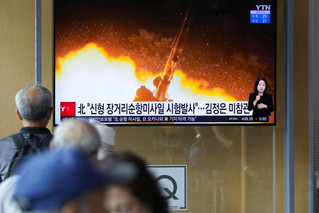After the truce of 1953 North Korea aims to acquire nuclear weaponconsidering it surrounded by the missiles the US has deployed in South Korea and Japan.
During 1960s, Pyongyang receives from the Soviet Union, its historic ally, the technology and materials intended for the North Korean nuclear program.
Pyongyang, as reported by the Athens-Macedonian News Agency, is establishing a research center for atomic energy in Yongbyon, north of Pyongyang.
At the end of 1970s, the communist regime begins work on a Soviet model ballistic missile Scud-B, which it tested for the first time in 1984, before developing medium- and long-range missiles, including the Taepodong-1 (2,500 km) and the Taepodong-2 (6,700 km).
In 1998, the Taepodong-1 missile was tested for the first time, flying over part of Japan before falling into the sea.
First nuclear test
The 2005under the guise of a “hostile” US policy, Pyongyang is ending a six-year-old moratorium onfiring long-range missiles. The 2006North Korea conducts its first underground nuclear test.
The UN votes on the first package of economic sanctions against Pyongyang, which have since been repeatedly extended.
In 2009, North Korea withdrew from the six-party negotiations (North, South Korea, Russia, USA, Japan) that had started in 2003 on Pyongyang’s nuclear program.
The 2011The Kim Jong Un succeeds his father. The North Korea’s nuclear and ballistic missile programs are accelerating.

At his beginings 2022following a series of tests involving hypersonic missiles and a “medium-to-long-range Hwasong-12 surface-to-surface ballistic missile,” Pyongyang is proceeding with the March 24 launch of an intercontinental ballistic missile that fell into Japan’s Exclusive Economic Zone.
This missile is the most powerful launched since 2017. Pyongyang says it is a new Hwasong-17. Washington and Seoul suspect it is an older Hwasong-15.
In mid-April, Kim Jong-un oversees the launch of a new weapons system that will increase the effectiveness of his tactical nuclear weapons.
In the same month, he warns that North Korea will accelerate the development of its nuclear arsenal. This is followed by the launch of a series of ballistic missiles in May.
On May 25, the day after US President Joe Biden visited Asia to express his support for Seoul and Tokyo against Pyongyang, North Korea launched three missiles, including an ICBM.
On June 5, North Korea launches eight short-range ballistic missiles. South Korea and the US respond the next day by launching eight missiles respectively.
In early September, North Korea adopts a law allowing it to carry out a pre-emptive nuclear strike and declares that its status as a nuclear power is irreversible.
On October 4, North Korea launches an intermediate-range ballistic missile, according to the South Korean military. The missile flew over Japan for the first time since 2017, prompting Tokyo to activate the alarm system and ask the population to go to shelters.
Source: News Beast
I’m Robert Neff, a professional writer and editor. I specialize in the entertainment section, providing up-to-date coverage on the latest developments in film, television and music. My work has been featured on World Stock Market and other prominent publications.




.jpeg)
.jpg)
